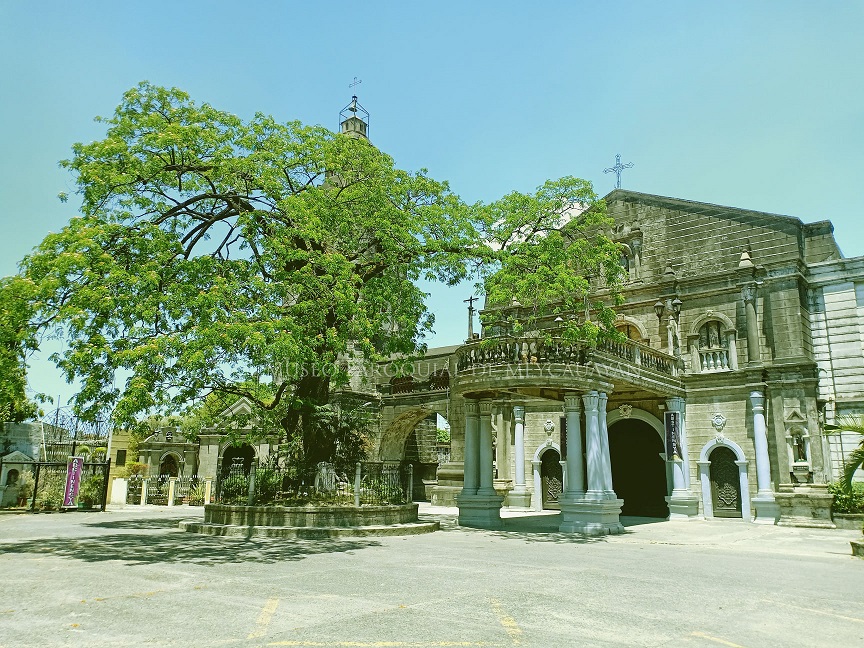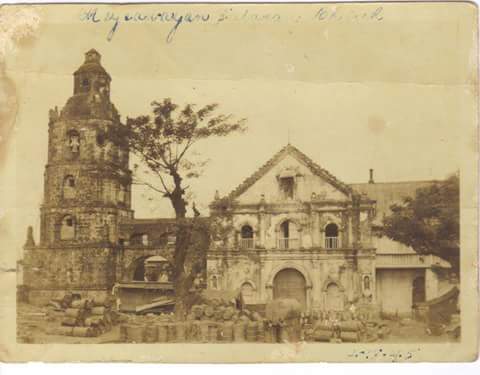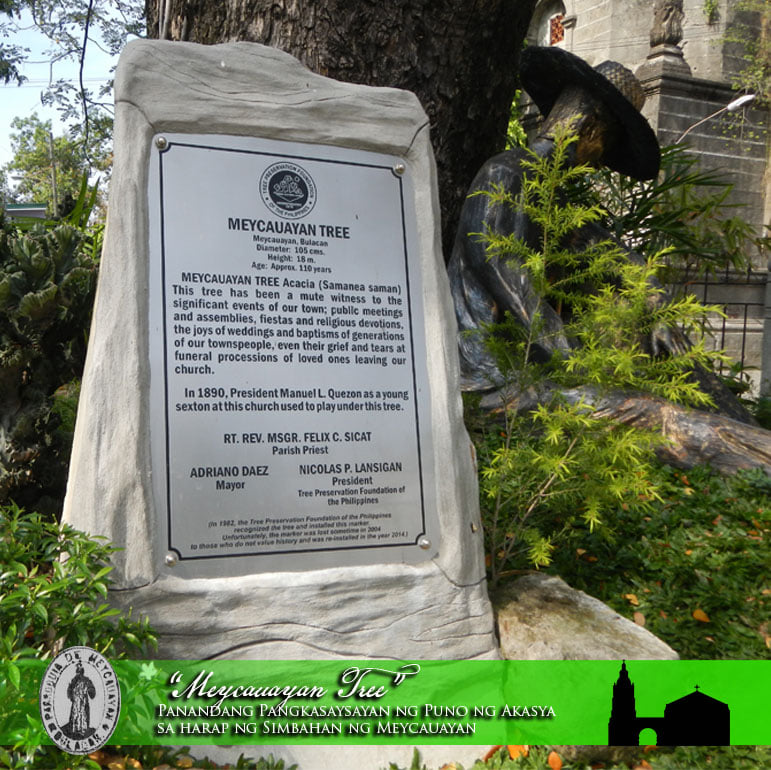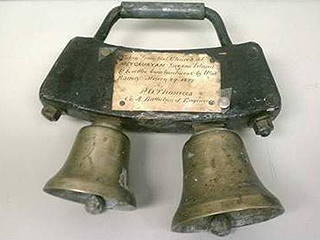Meycauayan Church, or the Saint Francis of Assisi Parish Church, is a Roman Catholic church located in Meycauayan, Bulacan Province. The Church was founded in 1578 and is one of the oldest parishes in Bulacan, older than the Malolos Cathedral, established in 1580, and the Barasoain Church, established in 1859.
Meycauayan Church

The parish was founded in 1578 by Fr. Juan de Plasencia and Fr. Diego de Oropeza, the first batch of Franciscan priests to reach the Philippines in 1577. They built a small church made of nipa thatch and bamboo in a small area called Sitio Torril, which is now part of Brgy. Bahay Pare in Meycauayan. A typhoon blew the Church in 1588.
The Franciscans also brought a wooden missionary cross when they arrived in Meycauayan, similar to Magellan’s Cross. The cross was later found to be in possession of a resident of Brgy. Bahay Pare. The cross, now known as The Cross of Sitio Torril, is the oldest known religious relic in Meycauayan.

Every October 4, the cross is brought from Barangay on the feast day of the town’s patron saint, Saint Francis of Assisi. Bahay Pare to the Meycauayan Church for public veneration.
During the colonization of the Spaniards, Meycauayan was known as Mecabayan. In 1591, its status was encomienda, a formal system of forced labor in Spanish colonies. Under this system, leaders of the indigenous community paid tribute to colonists with food, cloth, and minerals or by providing laborers.
Meycauayan, at the time, was one of the largest municipalities in Bulacan. The towns of San Jose del Monte, Bocaue, Marilao, Valenzuela, Obando, Santa Maria, Balagtas, and Pandi were once part of the political jurisdiction and are part of Meycauayan.
During the Spanish colonization, the Spanish authorities tapped Meycauayan’s rich adobe deposits (volcanic turf rocks), which were used for building stone houses and fortifications in and out of town. Most of the adobe rocks used in making the walls of Intramuros, Manila’s “old walled city,” were imported from Meycauayan.
The Meycauayan Church was transferred to its site in the present Poblacion (town center) due to the attacks of the native Aetas. In 1668, Fray Nicolas Santiago started the construction of the stone church that measured “sixty yards long by wide twelve and a half wide” (60 by 12.5 yards (180 by 38 ft; 54.9 by 11.4 m).
The Meycauayan Church also served as one of the prototypes of city planning under the Spanish government’s reduction policy; Meycauayan was among the first towns in the colony that had the parish church and the city or municipal hall adjacent to each other, if not housed within the same vicinity.
In 1800, the bell tower was constructed by the order of Fr. Francisco Gascueña, OFM. The said tower is one of its kind in the Philippines, with a large arch bridge connecting the Church and the building.
Both the Meycauayan Church and convent were occupied.
They became the temporary headquarters of the American soldiers in May 1899 after the Filipino revolutionaries captured it during the Philippine–American War.
Some church possessions were believed destroyed or looted during their stay in the church complex.
During World War II, the Meycauayan Church survived the destruction, unlike the fate of the churches in Manila. In 1946, then-future President Diosdado Macapagal and former First Lady Dr. Evangelina Macaraeg were wed at the Church.
Former Commonwealth President Manuel Luis Quezon also had fond memories of the Meycauayan church, playing in its vicinity in his youth.

A massive fire destroyed the Church in 1949, known as the Great Fire of Meycauayan. Artifacts such as old memorabilia, statues, church vestments, records, ciboriums, and chalices are some of the casualties of the fire. The retablo in the Spanish colonial style was destroyed. Only a few church items, including the tabernacle, were saved from the fire.
In 1984, one year after Former Senator Benigno Simeon Aquino Jr’s assassination, the Church became the refuge of a political activist when the marchers commemorating the anniversary of Ninoy’s untimely death in a political march called Tarlac-to-Tarmac were prevented from entering Metro Manila by the Philippine Constabulary with a barricade on MacArthur Highway, at the boundary between Meycauayan and Valenzuela towns.
Support for the marchers snowballed from the residents of Meycauayan and the nearby towns, and the marchers were invited to stay in the Church during the standoff.
With the outpouring of support for the marchers, the former strongman President Ferdinand Emmanuel Edralin Marcos Sr., finally allowed the marchers to proceed to the Manila International Airport, the final destination of the march after a day of waiting.
The Church has undergone significant and minor renovation to restore its former magnificent glory. There have been recent efforts to restore and renovate the Church.
A belfry was constructed by the order of Fr. Francisco Gascueña, OFM. The said tower was one of its kind in the Philippines because of its large arch bridge connecting the Church and the building.
It houses five bells: namely Maria Concepcion, the biggest, which was made by order of Fr. Antonio de Cudajara in 1878; San Francisco, dedicated to the town’s patron saint made by order of Fr. Juan Fernandez in 1881; San Jose, the smallest produced by order of Fr. Francisco Gascuena; and the two others were destroyed by the attack of Li Ma Hong’s army.
The 5 lbs. bells (and link, 2.27-kilograms) were taken (as war booty from the Church of Parish of St. Francis of Assisi) during the Philippine-American War in 1899 (more than 400 years old, 10 x 3.5 inches attached to a block of hard black wood with a metal handle with a parchment inscription: “Taken from the Church at MEYCAUAYAN, Luzon (sic) Islands after bombardment by Utah Battery March 29, 1899. By P.O. Thomas, Co. A Batallion of Engineers.”)

The “Meycauayan Bells,” a heritage piece of the artifact, was retrieved from Omaha, Nebraska, on July 2011 (discovered by archivist Monte Kniffen of the Sisters of Mercy in Red Bluff, California, and later bestowed by Sisters of Mercy Midwest Community USA President Sister Judith Frikker, RSM to Philippine Consul General to Chicago Leo M. Herrera-Lim on October 2011.
On March 9, 2012, Albert del Rosario formally gave the two bells to Director Jeremy Barns of the National Museum of the Philippines. On August 6, 2012, the Roman Catholic Diocese of Malolos received the same and became part of the Diocesan Museum.
Read Disgusting Meycauayan River ranked 5th in Global List of Plastic-Emitting Rivers 2021, Lydia De Vega: Remembering Bulakenya Sprint Queen, and Bulacan Election Results 2022
Sources:
- The beauty of Meycauayan Church. The Beauty of the Philippines. (2023, January 3). Retrieved February 8, 2023, from https://www.beautyofthephilippines.com/meycauayan-church/
- Meycauayan Church. Ang Tubong Meycauayan Facebook Page. (n.d.). Retrieved February 8, 2023, from https://www.facebook.com/568453066664096/posts/meycauayan-church-founded-1578parish-church-of-st-francis-of-assisi-poblacion-me/596253680550701/